Agave attenuata



Soft wooded
No secondary (woody) tissue being formed. The texture is fleshy and is soft, easy to cut.
Clumping
A plant that when multiplies forms a clump.This perennial succulent has fleshy blue-green lanced-shaped leaves in a rosette on a short twisted trunk and forms a rounded clump. The small green-yellow funnel-shaped flowers appear in a long tapering cluster on a tall stem from spring to summer.
Agave attenuata Salm-Dyck, is naturally found from central and western Mexico in southern North America. It grows in small colonies on the mountains and hillsides, appearing at an elevation from 1,900 m to 2,500 m (6,200 to 8,200 ft) and is rare in it native habitat. It prefers a very well drained but moist sandy-stony to loamy soil that is moderately fertile and slightly acidic with a pH range from 6.0 to 7.5. It prefers an open to exposed sunny to semi shaded position and is frost tender but very drought tolerant with a preferred minimum winter temperature of -2ºC (28ºF). It is also rabbit and deer resistant and tolerates neglect.
The Century Plant is grown for its attractive spineless fleshy leaves and its large drooping flower stem. It is planted in rockeries or along borders as a specimen or in group plantings tolerating exposed positions. It is also grown in patio pots and planter boxes, tolerating neglect and is mass planting on embankments. It has a vigorous growth rate establishing in 1 to 3 years suckering freely forming colonies. It has a low water requirement once established (Scale: 1-drop from 3), preferring to be mulched and have reliable moist organic rich soil but will tolerate dry periods.
I.D. 288
UK hardiness zone H1c
Climate zones 13, 20 - 24, H1, H2
USDA zones 9-12
Agave (a-GAH-vee ) attenuata (a-ten-ew-AH-ta)
Etymology
Genus: - Latin from Greek - Agave – from ‘agaue’ the name of one of the daughters of Cadmus in Greek mythology also ‘agauos’ meaning (of kings and heroes) referring to being (noble), may be referring to the tall flower spike
Species: Latin – attenuata – from ‘attenuate’ meaning (drawn out) referring to the gradual reduction of the leaf to its acuminate apex
Cultivar
'Boutin Blue' syn. 'Nova'
Blue Fox Tale Agave
This perennial succulent is similar to the species, growing to 1m (3ft) tall and wide but differs in having bluer leaves that are wider and the inflorescence is erect rather than arching.

Mexico (central and western)
Agavaceae (ah-gav-AY-see-ee)
Distribution
This family occurs in the tropics, sub-tropics and semi-arid areas.
Diagnostic Features
The leaves are fibrous and fleshy growing from a rhizomatous base as a tuft or on the ends of a woody stem.
The bisexual flowers are normally arranged in a raceme or panicle with six perianth segments in a whorl and are fused.
The flower has six stamens and the ovary is superior or inferior and has three carpels that contain three chambers.
The style is unbranched and the ovary chamber has one to many ovules.
The fruit may be a capsule or berry and contains one to many seeds that have a fleshy endosperm.
Note:
Some species are used for food, alcoholic drink, and commercial fibres and for ornamental uses in domestic gardens.
Plants are classed as succulents as they resemble each other. They have fleshy leaves and stems, which can store water.
Most of the succulents are indigenous to semi-arid environments with long dry periods followed by a short wet period. The plants swell absorbing water during these wet periods and reduce evaporation by having a waxy cover over the leaves or the leaves are crowded together in a rosette. Hairs and spines (modified leaves) also reduce the evaporation of water and most succulents form rounded shapes to reduce the surface area of the plant.
The size of the plant and flowering period is difficult to predict with succulents as the environmental factors such as weather and light variations control the flowering period. Soil type and available moisture influence the growth.
This plant tolerates between USDA zones 9a to 12a and grows to 1 m (3 ft)
Fahrenheit 20º to 55º F
These temperatures represent the lowest average.
Celsius -6.6º to 12.7º C

Attention
This plant was last revised on the 27/7/2020
The information displayed on this plant is based on research conducted in our horticultural library and from reliable online resources. We also make observations of the plant that we photograph, and all care is taken to ensure the details are correct.
All photographs and data are covered by copyright. Apart from any fair dealing for the purpose of private study, research, reference or review, as permitted under the Copyright Act, no part including images and text may be reproduced by any means without written permission. The information presented in the map is only indicative and may contain errors and omissions. All inquiries should be addressed to sales@plantfile.com attention Peter Kirkland.

Simple
The leaf that is not divided.
Ovate
The leaf that is broadest at the base tapering towards the apex.
Rosette
A cluster radiating from a common source.
Entire
A leaf margin with no irregularities (smooth).
Funnelform
A flower where the petals form a funnel shape.
Cluster or Fascicle
A general term describing flowers that are arranged in closely packed bunches.| Jan | Feb | Mar | Apr | May | Jun |
| Jul | Aug | Sep | Oct | Nov | Dec |
The small 15 mm (2/3 in) long greenish funnelform flowers are arranged in a long spike-like cluster along an arching scape that is up to 2 m (6 ft) long. It emerges after several years from the centre of the plant appearing from spring to summer or sporadically throughout the year. Once a plant finishes flowering it dies off.

Capsule
A dried dehiscent fruit, with an enclosing membrane normally containing may seeds."| Jan | Feb | Mar | Apr | May | Jun |
| Jul | Aug | Sep | Oct | Nov | Dec |
The fleshy green oblong capsule is up to 30 mm (1 1/8 in) long and turns brown on maturity. It contains numerous small dark seeds that are viable but the plant is normally reproduced vegetatively.
The Century Plant is grown for its attractive leaves and its clumping habit. It is planted in rockeries or along borders as a specimen or in group plantings tolerating exposed positions. It is also grown in patio pots and planter boxes, tolerating neglect and is mass planting on embankments. It is quick growing and establishes in 1 to 3 years suckering freely.
General cultivation notes
Outdoor Cultivation
In warm regions with low humidity, cold and frosty night's cacti and succulents grow well outdoors. The more humid atmosphere will limit the number of successful species. All of these plants require a very well drained soil and ample sunlight to succeed. Once established these plants require minimal maintenance.
Indoor Cultivation
Cacti and succulents grow well in glasshouses or near a sunny window with some ventilation tolerating a marked difference in day and night temperatures.
Cacti have a rest period during mid winter when they can be stored in a cooler area with reduced watering, once every two months. Protect the plants from freezing temperatures or extreme direct hot sunlight behind glass. All plants prefer a period outdoors during summer.
Watering
These plants normally have wet and dry periods. Watering should take place during the growing period of the plant. When new growth appears water well once a week and never water if the soil is already wet or place the pot in a saucer of water. Free drainage is essential for a healthy plant and succulents rot easily in moist humid conditions.
Problems related to watering.
Overwatering succulents results in leaves that wilt and discolour or stems that rot.
Under-watering results in a sudden loss of leaves or brown and dry spots on the leaves. The leaves also fall if the water is too cold.
Pots
Both clay and plastic pots are suitable. The pot should fit the plant comfortably and not be too big as it may remain moist, rotting the plant. Water only when the soil has dried.
Re-pot only when necessary in to a slightly larger pot for older plants. If the plants are very large replenish the surface soil and thoroughly water.
Sow fresh seed during spring and maintain a temperature of 18º to 21º C (64º to 75º F). Divide suckering plantlets which are easily transplanted. The trunk may be cut off and then planted directly to a bed but don't over water.
Propagation by Seed (General)
Germination
In order for a seed to germinate it must fulfil three conditions.
1. The embryo must be alive (a viable seed).
2. The seed must have no dormancy-inducing physiological, physical or chemical barrier to germination; also the seed must be nondormant.
3. The seed must have the appropriate environmental requirements, water, temperature and oxygen.
The interaction between these requirements and dormancy is complex and may lead to different environmental requirements that avoid the dormancy of a seed.
Sowing Seeds in Containers
There are two general methods for germinating seeds.
1. Sowing seeds in a flat or germinating bed, through which seedlings are pricked-out then, transplanted into another flat with wider spacing or directly to an individual pot.
2. Sowing seeds by placing them in to flats with the appropriate spacing or into individual pots.
This method is normally carried out with medium to large seeds such as woody plants and plants that are difficult to transplant.
Seedling production normally occurs in a greenhouse / glasshouse, cold frames and on hot beds.
Method of Seed Sowing
Fine seed is sown in pots or flats that are no deeper than 70 to 80 mm. using a sterilised well-drained media (soil). Fill the container to 20 mm from the top and sprinkle sieved peat to 3 mm depth.
Press the media down level and firm with a piece of timber and then thoroughly moisten.
Mix the fine seed with washed sand and then sow thinly on the surface. These may be lightly covered with sand.
Larger seeds may be covered with media or a hole is dibbled and the seed is placed in the media.
Watering Methods
For watering you may either mist the containers from above or place the container in tepid water and allow the water to raise through the pot to the surface of the media, then drain away and do not fill to the top of the container.
Place a piece of glass over the pot and store in a protected warm environment (glasshouse).
Seeds germinate best in darkness so shade the containers if in direct sunlight.
After the seedlings have sprouted remove the glass and ease the seedlings into direct light.
When the seedlings are large enough prick them out and transplant into larger containers then place them in a shade-house to harden off.
Many seeds have different methods of seed preparation for germination such as nicking or cutting the seed coat to allow water penetration, also placing seeds in hot water and allowing it to cool off.
This is particularly important as it is softening the seed coat.
Layering (General)
Factors associated with layering.
1. Nutrition
The stem is still attached to the plant and the intact xylem supplies water nutrition. To initiate roots on an intact stem requires certain factors.
2. Stem Treatments
Adventitious roots are induced by the interruption of downward flow of nutrients and organic material from the leaves. Roots occur as if it is a cutting.
3. Light Exclusion
The best results occur with the stem continuously being covered with rooting medium.
Blanching - the covering of a stem that has already formed.
Etiolation - the growing of the stem (elongating) due to the absence of light.
Both of these methods are employed either singularly or together and may require phloem interruption to induce root formation.
Physiological Conditioning
Timing of root induction normally occurs at the end of the growing season as the carbohydrates are moving towards the roots.
Root formation depends on, continuous moisture, ample aeration and a moderate temperature in the rooting area.
Uses of Layering
1. To propagate plants that naturally layer.
2. To propagate plants that doesn't root easily as cuttings.
3. To produce a large-size plant in a short time.
4. To produce a small number of good size plants with minimal propagation facilities.
Methods of Layering
Tip Layering
This method is used on plants that produce long arching canes. The tips of these canes are placed into a hole that is sloped on one side towards the plant. This is method is carried out towards the end of the growing period. The shoots are buried facing the blunt end of the hole.
The etiolated shoot form roots and a new vertical shoot occur.
Simple Layering
This type of layering is carried out during early spring with dormant one-year-old shoots or during autumn with mature new growth.
The branches are bent over to the ground and pegged in a hole. Root stimulating may be induced with, girdling, wiring, bending and notching.
The roots are produced through the first season and may be severe and lifted during autumn or the following spring.
It is advisable to stack the emerging shoot to maintain a good shaped plant.
Compound or Serpentine Layering
This is a simple layering method where the flexible stems are covered and exposed then covered again. This will produce several plants from the one branch.
Air Layering
This method is used to propagate tropical and sub-tropical plants. It is carried out during spring on the previous season's growth or in tropical conditions after the first new leaves are produced.
First, girdle or remove the bark on the stem about 20 mm (¾ in) long and ensure that the phloem and cambium is removed. Place sphagnum moss over the exposed branch and then covered with a piece of polyethylene film so that the folds join is facing down. The two ends are twisted around the branch and tied or taped up the branch so the water cannot seep in.
Aluminium foil may be also used for this procedure. The layer should be left till autumn, though this will depend on the growth rate of the plant.
When removing from the parent plant reduce the top part of the foliage in relation to the root size then pot up and place in a moist humid environment (misting bench). Harden off in a few weeks.
Mound Layering
This form of propagation is used in the production of rootstocks for, apple, pear, quince and gooseberries. The mother plant is planted in a small trench in rows one year before layering takes place.
The next spring the plants are cut back to ground level. Three to five shoots appear and when they reach 15 cm a mixture of sawdust and loose soil is mounded half way up.
This action is carried out twice more, when shoots reach 30 cm (1 1/8 in) and during mid summer. In all cases the mounding should not exceed half the total hight of the shoot. Girdling 6 to 8 week into the growing period will encourage Roots to occur in the mound.
Layered shoots are cut away from the mother plant during autumn and planted in a nursery row.
Trench Layering
This is a form of layering used for woody plants that are difficult to root in mound layering. The method involves the mother plant being planted in a trench on a 30 deg. angle one year before layering.
The following year the plant is bent over and pegged in the trench flat. As new vertical shoots appear during spring they are systematically buried before the buds swell with a rooting medium of peat or sawdust soil mix. This causes etiolation and a second layer of medium should be applied to the shoots before the buds expand.
When the shoots reach 20 cm (7 ¾ in) a final layer of medium should be applied.
At the end of the season the rooting medium is removed and the rooted shoots are cut from the mother plant.
Natural layering
Runners
These are stems that grow horizontal from the mother plant and form new plants from a node that form its own root system. When these daughter plants root up in the soil they are dug up and planted as a new plant.
Stolons
These are modified stems that grow horizontal to the ground or under the ground with nodes that can produce new plants as in a potato tuber. These can be cut away from the mother plant and form a new plant.
Offsets
This is a lateral shoot that forms from at the base of the mother plant. Often referred to in bulbs as bulblets or lateral branching in monocotyledons and appear as thickened stems and are removed close to the main stem. These natural methods are slow but microporpagation in aseptic culture has greatly enhanced production.
Suckers
The true meaning of a sucker is a shoot that comes from an adventitious bud on the roots, but generally it is referred to any shoots that arise from the crown of the plant. A sucker may be also seen as any shoot on a rootstock that is below the grafted section.
The method of removal is to dig out and cut it away from the mother plant with some roots attached to its base. It is then treated as a cutting, potted up and kept moist. This operation is normally carried out during the dormant period of the plant.
Crown Division
The crown is the part of the plant at the surface of the soil where new shoots arise. With lateral shoots the crown of some plants requires division when they become crowded.
Herbaceous perennials and multi-branched woody shrubs may develop large crowns that need dividing.
It is a simple method of propagation that is used by amateurs and professionals for a small increase in plants.
Plants that flower during spring to summer are divided during autumn and if flowering in summer to autumn they are divided in spring. The crown is dug up and cut with a knife in to sections, which has a shoot and abundant roots then planted or potted up. The crown may also be divided in some species by using a shovel to cut and dig sections out.
PEST
NAME
Thrips (General)
Various Thrip Species
ORDER
Thysanoptera
Description of the Pest
There are many species of thrips that attack living and dead plant material. The winged adults are black, yellow, white or brown with slender bodies and up to 2mm long. The folded fringed wings appear as silvery stripes and the smaller nymphs are difficult to see, but are wingless simular to the adults. Both adults and the first two nymphal stages have rasping and sucking mouthparts.
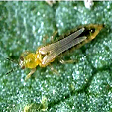 Thrip species
Thrip species
Boree Gall (Kladothrips species) adults are gall producing thrips that form smooth bubble-like or irregular spiny growths on the leaves. These galls can contain up to 1000 insects that also reproduce inside, and are trapped until the gall dries or splits open. Commonly found in inland areas attacking the phyllodes of Acacia species.
Glasshouse Thrips (Heliothrips haemorrhoidalis) is a slender up to 15mm long with small fringed wings. The adult lays eggs on the underside of leaves where the nymphs emerge as miniature adults but wingless. Then feed on the soft leaves leaving a silvery mottled appearance.
Appearance and Distribution of the Pest
Thrips are found from tropical to temperate regions preferring a cool mild winter followed by a dry sunny spring that produces abundant flowers and new foliage. It is dispersed by flying and can be carries great distances on the wind.
Life Cycle
These insects have a Hemimetabolous life cycle, ie. When the immature nymphs resemble the adults.
The female adult lays her eggs using an oviposit in a slit on flower stems or occasionally leaves. The eggs develop into four nymphal stages. The first two stages occur on the plant and the last two in the surrounding soil or in leaf litter, emerging as adults and flying to reinfect the plant. It takes ten to thirty days to develop from egg to adult depending on the temperature and rainfall. Under opium conditions thrips are produced in plague proportions.
Period of Activity
Thrips are most active during warm dry, calm weather, but dislike the soil to be too dry or wet.
Damage Caused
Thrips congregate inside the flowers damaging the epidermal layer, allowing sap to leak out. This causes the flower petals to become brownish and curl along the margins. They also attack the upper surface of leaves causing a silvery discolouration as they suck the sap. The effect is a reduction in fruit and seed production on the host plant.
Susceptible Plants
Generally many plants species are attacked by thrips including buds, petals and leaves that are soft are at most risk, such as Alyogyne , Baeckea, Hibbertia, Hibiscus and Leptospermum species. There is also a wide range of ornamentals suseptable to attack including apples, pears, citrus, stonefruit, grapes and strawberries.
Buddleja species may be attacked by the thrip (Hercinothrips femoralis).
Cordyline, Agave, Dracaena and Howea species, Ficus elastica are attacked by the Dracaena Thrips (Parthenothrips dracaenae) which feed of the leaves.
Knightia excelsa is attacked by thrips by feeding on the chlorophyll in the leaf causing significant paling of the leaves. Stresses plants are more susceptible and plants rarely die from attack.
Peperomia, Cissus, Tropaeolum and Passiflora species and some fern species are attacked by Glasshouse Thrips which can cause heavy damage in inclosed areas such as a glasshouse.
Watsonia species are attacked by the Gladiolus Thrips (Taeniothrips simplex).
Cultural Control
There is no satisfactory cultural control. Small infestations may be ignored or the plant may be hosed to reduce the numbers. Removal of surrounding leaf litter, weeds and cultivating the soil can also reduce the numbers and disturb the life cycle. Care should be taken not to remove flowering weeds under trees that are in bloom as the thrips may migrate on to the tree, alternatively flowering annuals can be planted under trees to attract the thrips away.
Biological Control
No effective natural control though birds; wasp and other predators eat thrips. Weather conditions such as heavy rain help reduces numbers.
Chemical Control
Thrips can be sprayed with Dimethoate or Maldison at least twice every ten days to kill newly hatched nymphs, but may have a detrimental effect on other insects such as bees.
Note
Always read the label for registration details and direction of use prior to application of any chemicals.
PEST
NAME
Scale Insect
Various Scale Species
ORDER
Hemiptera
Description of the Pest
Generally scales are soft bodied insects that have a hard (armoured) or soft covering to hide under. They have piercing and sucking mouth parts that are attached to the host, feed off sap and soft scales commonly producing sweet honeydew, which in turn attracts sooty mould and ants.
The adult female has a circular or oval covering depending on the species and is up to 8mm across. The first stage (crawlers) hatch and wander around the leaf surface until finding a suitable place to suck sap, normally in colonies and the smaller male is relatively inconspicuous.
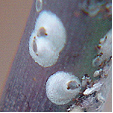 Hard Scale
Hard Scale 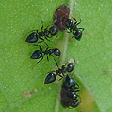 Soft Scale, attending Ants
Soft Scale, attending Ants
Cactus Scale (Diaspis echinocacti) has a circular greyish female and a narrow white male scale and is commonly found on house plants.
Chain Scales (Pulvinaria species) adult females are obvious with large group of eggs that are white or cottony-like, and the tiny young light green scales are flat and oval-shaped up to 2mm long. The legged nymphs are normally arranged from head to tail along the mid rib of the leaf, and may move to a new position to feed. They excrete honeydew and attract sooty mould and are found on Acacia and Acronychia species.
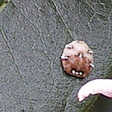 Chinese Wax Scale
Chinese Wax Scale
Chinese Wax Scale (Ceroplastes sinensis) is a domed wax scale that has dark spots around its margin and immature scales form waxy material around there margins.
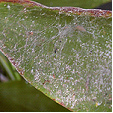 Fern Scale on Aspidistra elatior
Fern Scale on Aspidistra elatior
Fern Scale or Coconut Scale (Pinnaspis aspidistrae) appears as flecks up to 0.15mm long with a white covering over the male congregating on the underside of the fronds on the axils and among the sporangia causing them to turn yellow. Many species of fern are susceptible to infestation.
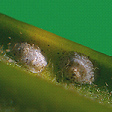
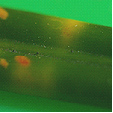 Flat Brown Scale
Flat Brown Scale
Flat Brown Scale (Eucalymnatus tessellates) are light brown up to 0.5mm long, flat and closely attached both sides of the leaf and causing yellowing of the foliage.
Juniper Scale (Diaspis carueli) is tiny and circular, white maturing to grey-black and as it feeds the needles turn yellow and die.
Oleander Scale (Aspidiotus hederae) is a pale yellow circular scale up to 3mm across and is found in dense colonies on the stem or leaves.
Tea-tree Scale (Eriococcus orariensis) are a creamy blue colour normally packed along the branches and are plump and rounded to 4mm across.
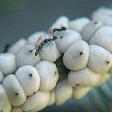
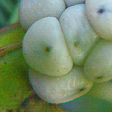 Wattle Tick Scale
Wattle Tick Scale
Tick or Wattle Scale (Cryptes baccatus) adult is domed, blue-slate colour with a leathery covering up to 10mm long. All stages of growth are found in groups of over forty, packed along the stems and normally tended by ants as they produce large amounts of honeydew. A serious pest of Acacia species found inland or coastal from temperate to sub tropical climates and commonly accompanied by Sooty Mould.
Toxic Scale (Hemiberlesia lataniae) is a tiny flat rounded scale up to 0.15mm long and is white to pale pink. It is normally found in colonies on the small branches and twigs of shrubs. It injects a toxic substance into the host as it sucks sap causing the death of the branch.
Wattle Scale (Pseudococcus albizziae) is soft, plump and secrets cotton-like threads. It is not a true scale insect and is simular to mealy bugs. It is reddish-brown up to 0.4mm long and secrets large amounts of honeydew as it sucks sap in colonies along the branches.
Life Cycle
These insects have a Hemimetabolous life cycle, ie. When the immature nymphs resemble the adults.
Appearance of the Pest
All parts of the plant above the soil may be attacked, but normally the stems and leaves and scale tends to favour well-lit positions.
Period of Activity
The nymphs and females are active for most of the year, in warm climates. Once they selected a position they attach and don't move. Normally the winged or wingless males are mobile and only soft scales produce honeydew.
Susceptible Plants
There is a wide range of susceptible plants including citrus, willows, holly, and many ornamentals, such as roses or Paeonia species. It also attacks indoor or glasshouse plants and Australian native plants such as wattles, hakeas, grevilleas and eucalyptus.
Acacia species are attacked by the Tick or Wattle Scale, which infest twigs and small branches and heavy infestations will kill the host plant.
Acer species are attacked by the Cotton Maple Scale (Pulvinaria innumerabilia) which prefers Acer saccharinum. Nymphs first attack the leaves and the brown adult scale is covered in a woolly mass up to 14mm across, normally found on the underside of the stems and twigs.
Acmena smithii, Melaleuca, Syzygium and Pittosporum species are attacked by the Chinese Wax Scale.
Aesculus species are attacked by several scale insects including the Walnut Scale (Aspidiotus juglans-regiae) which is saucer-shaped and attacks the main trunks.
Agave species are susceptible to several types of scale including (Aspidiotus nerii), (Aonidiella aurantii) and (Pinnaspis strachani), but generally do not require control.
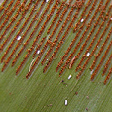 Asplenium australasicum
Asplenium australasicum
Asplenium australasicum is susceptible to Coconut Scale or Fern Scale (Pinnaspis aspidistrae). It is normally found on the under side of the fronds. Small infestations cause little damage.
Bougainvillea species may be attacked by the soft scale (Coccus hesperidum) outdoors or under glass.
Calluna and Vaccinium species are attacked by the Oyster Shell Scale (Lepidosaphes ulmi).
Camellia species may be attacked by the Florida Red Scale (Chrysomphalus aonidum), which is small, circular and black and is found firmly attached to the underside of the leaf along the veins. On inspection after removing the scale the insect has a pale yellow body. Camellias are also attacked by a large variety of scale insects including Tea Scale and Camellia Scale.
Carpinus species may be attacked by the scale (Phenacoccus acericola). It is found on the underside of the leaves forming a white cotton-like clump along the veins.
Casuarina and Allocasuarina species may be attacked by the Casuarina Scale (Frenchia casuarinae), a black hard scale that is upright to 4mm with a pinkish body. During attachment the surrounding tissue swells up and in time can, form galls. This weakens the wood and in severe infestations may kill the tree.
Cotoneaster species are attacked by up to four species of scale including the Oyster Shell Scale (Lepidosaphes ulmi).
Cupressus species are attacked by Bark Scale (Ehrhornia cupressi) is pink and covered in white wax. Heavy infestations cause the leaves to turn yellow or reddish.
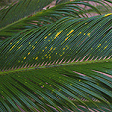 Flat Brown Scale on Cycas revoluta
Flat Brown Scale on Cycas revoluta
Cycads, palms and some species of Callistemon are attacked by the Flat Brown Scale.
Erica species are attacked by several species of scale including, Greedy, Oleander and Oystershell scale.
Jasminum species can be infested with up to twelve types of scale.
Juniperus x media and other conifer species are attacked by the Juniper Scale.
Leptospermum species are attacked by the Tea-tree Scale which produces ample honey dew that promotes sooty mould.
Palm and Fern species are susceptible to attack by the Coconut Scale or Fern Scale (Pinnaspis aspidistrae) which infests the underside of the leaves. They are also hosts for many other scale species such as red, cottony cushion and tea scale.
Pinus species are attacked by several species of scale including the Pine Tortoise Scale (Toumeyella numismaticum) and the Red Pine Scale (Matsucoccus resinosae).
Polygonum odoratum is attacked by a small brown scale.

Sorbus aucuparia is attacked by a five species of scale insect, including Black Cottony Maple, San Jose and Scurfy. Generally they suck on the sap of the new growth and leaves.
Strelitzia species are attacked by the Greedy Scale (Aspidiotus camelliae).
Damage Caused
Leaves become yellow and are shed prematurely and there may be twig or stem die-back. When the infestation occurs on fruit, the fruit is small and its skin becomes pitted and cracked. Small trees and saplings that are heavily infested may be seriously damaged or die. Sooty mould can cover fruit or leaves causing a secondary problem.
Cactus Scale can completely cover the host cactus sucking sap and causing it to die.
Cultural Control
Dead or damaged parts of the plant should be removed and destroyed including fallen fruit. Small infestations may be removed by hand or squashed on the stems. Healthy plants are less susceptible to attack, so maintain vigour of the plant and avoid using high-nitrogen fertiliser that produces excessive soft young growth.
When pruning susceptible plants paint the cuts with antifungal sealant paint as scale insects are attracted to the sweet smell of the sap. This will reduce the infection rate of the plant.
Biological Control
Natural predators such as parasitic wasps may reduce numbers of active nymphs; parasitic wasps are bred commercially in some areas for this purpose. It should be noted, however, that wasps would avoid dusty conditions.
Other predators that assist in control are assassin bugs, ladybirds, lacewings, hover flies and scale eating caterpillars. A variety of birds also attack scales.
The control of ants that transport aphid from one host to another also reduces infestation and can be carried out by applying at least three greased bandages 5mm apart around the stem or trunk of the plant.
Chemical Control
Spray the entire plant with dilute white oil solution; a follow-up spray may be required after four weeks, for heavy infestations. Spraying of chemicals will also kill of natural predators and in some cases the secondary scale infestation is more prolific especially when using copper based chemicals.
Some chemical controls, such as methidathion, are available - please seek advice from your local nursery as to the suitable product for your area.
Note
Always read the label for registration details and direction of use prior to application of any chemicals.
DISEASE
NAME
Anthracnose (General)
Various Anthracnose Species
Description
This fungus is a casual organism that attacks leaves, flower, fruit, seed and twigs of the host.
Symptoms
Circular black spots appear primarily on the leaves or fruit but may also occur on the stems and flowers. The spots have a definite margin that may turn purple or black with age. As the spot enlarges the centre dries and may fall out giving the leaf a shot hole appearance or become sunken in some fruit while others form soft blackened areas. Infected leaves turn yellow then fall prematurely and fruit that is infected generally becomes black and rotten as it matures.
There are many variations in the symptoms depending on the type of plant and the species of fungus but generally as the fungal spots merge they form brownish to black dead areas.
Plane Anthracnose (Gnomonia platani) first appears on young leaves and as the leaves mature light brown spots appear along the veins and eventually engulf the entire leaf causing death. The twigs are also infected and often fall to the ground when dead and branches die after cankers appear lower down. This is a serious problem for Platanus occidentalis in North America.
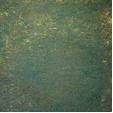 Anthracnose in turf
Anthracnose in turf
The Anthracnose (Colletotrichum species) and (Microdochium bolleyi) infects winter Turf Grasses. At first yellow patches appears which turn red brown then the leaf blades turn whitish and die. This forms bare areas and (Colletotrichum species) forms spine-like fruiting bodies that are tiny and can only be seen using a hand lens.
Wither Tip (Colletotrichum gloeosporioides) forms spots on the leaves and flowers and the stems form cankers that cause wilting at the top of the branches. Commonly found on Aucuba species.
Source and Dispersal
The fungal spores are dispersed by wind from infected plants or parts of plants. It is also dispersed by splashing water or contaminated stock.
Favoured Conditions
The fungus prefers cool humid climates and is not commonly seen in warm coastal regions and may continue living in dead wood, leaf litter or harvested fruit.
Affected Plants
The Anthracnose species is found shrubs, vegetables, trees particularly fruit trees such as mango or macadamia and large trees such as Platanus species.
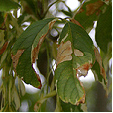
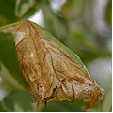 Acer negundo
Acer negundo
Acer species are infected by the Anthracnose (Gloeosporium aporcryptum). Irregular shaped light brown spots appear on the leaf, joining to form large dead brown areas and giving the leaf a scorched appearance. Leaves may be fully or partially damaged, often causing the leaf to die prematurely. During constant wet weather this can become a serious problem. Acer saccharinum (Silver Maple) and Acer negundo (Box Elder) are particular susceptible and small plants may be sprayed with a fungicide as the new foliage appears to help control infection
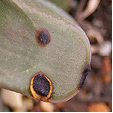
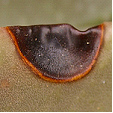 Agave species
Agave species
Agave species are susceptible to Glomerella Leaf Blight (Glomerella cingulate). This causes dark coloured depressed spots to appear on the leaves. The leaf apex dies and the spreading rot in Orchid species can infect the pseudobulbs causing the death of the plant.
Orchids such as Cattleya, Cymbidium, Cypripedium, Dendrobium, Epidendrum, Oncidium, Paphiopedilum, Phalaenopsis and Zygopetalum species are infected by Glomerella Leaf Blight (Glomerella cingulate).
Agrostis palustris (Bent Grass) is particularly susceptible to Anthracnose (Colletotrichum species) and (Microdochium bolleyi), but this fungal problem is also found on Cynodon dactylon (Couch), Lolium perenne (Ryegrass) and Festuca arundinacea (Tall Fescue). These grasses are infected in areas of poor drainage or where leaf wetness is prolonged. Low soil fertility may also contribute to infection and it is commonly found in coastal regions.
Anthurium species are susceptible to the Anthracnose (Gloeosporium minutum) which causes circular spots on the leaves, along the margins. These meld together forming dead brown areas that dry and fall out. It is commonly found in a glasshouse situation. The spadix is also infected by Spadix Blight (Colletotrichum gloeosporioides) which forms dark spots that enlarge, spoiling the flower.
Antirrhinum species are susceptible to the Anthracnose (Colletotrichum antirrhina) which attacks stems and leaves forming sunken oblong spots that are yellowish with a brown margin.
Cactus species are susceptible to anthracnose causing shot hole disease, which attacks the pads of Opuntia species (prickly pear). It appears and during the hot humid months of the year and is distinguished by the appearance of small brownish spots that turn grey with black spores under the drying skin. Control methods include removal of infected pads and treating wounds with disinfectant.
Digitalis species are infected by the Anthracnose (Colletotrichum fuscum). This fungus forms rounded spots that are purplish-brown and may have a purplish border. Fruiting bodies appear in the centre as the spots enlarge.
Leucadendron and Leucospermum species are susceptible to Anthracnose (Colletotrichum gloeosporioides). This causes the new growth to die back, leaf spots appear and cankers to form on the stems. It also causes damping-off of seedlings, which can be a major problem for Protea species as the fungus can be carried in the seeds.
Limonium species are infected by Wither Tip (Colletotrichum gloeosporioides). This is a serious disease causing spots on the leaf, flower and stems or rotting the crown.
Ribes species are attacked by (Pseudopeziza ribis). This infection causes circular brown-black spots on the leaves and premature defoliation of the plant. The spots may also appear on the petioles or stems. Infected areas may be sprayed with wettable sulphur weekly.
Schizanthus species are infected by Anthracnose (Colletotrichum schizanthi) which forms eater soaked areas on the stems and petioles, preferring new growth and maturing with canker-like lesions that girdle the stems.
Tilia species are infected by the anthracnose (Gnomonia tiliae), which forms light brown spots on the leaf venation, towards the tip and can defoliate an entire tree.
Spot Anthracnose (Elsinoe ilicis) infects Ilex cornuta forming black spots that may lead to leaf disorder. Opuntia species are infected by (Gleosporium cactorum) in warmer regions.
Vaccinium ovatum is infected by (Gloeosporium minus) and commonly known as Fleck and appearing on the leaf and stems.
Viola species are infected by (Colletotrichum violae-tricoloris) which produces brown blotches with black margins on the leaves.
Non-chemical Control
Avoid watering plants from above or wetting the foliage especially in the late afternoon. When planting allow space between each plant for good air circulation. Remove affected foliage or wood by pruning and dispose off site.
Turf grasses should have well drained soils, high fertility and avoid excessive watering to reduce possible infection.
Chemical Control
Regular spraying where possible during the periods that are favourable for fungus development. Fungicides include;
Systemic types, Biteranol, carbendazim, triforine
Protectants; chlorothalonil, copper oxychloride, mancozeb, thiram, zineb
Note
Always read the label for registration details and direction of use prior to application of any chemicals.
DISEASE
NAME
Leaf Spot (General)
Various Leaf Spot Species
Description
There is a wide variety of fungal leaf spots that infect perennials, shrub and trees. Some are specific to the host while others can affect a range of plants.
Symptoms
Generally light brown to purplish or blackish spots appear on the leaf and form concentric rings of fruiting bodies. The spots may leave holes, perforating the leaf or expand with pale green to yellowish margins and when the holes merge the leaf normally dies. There are many different types of leaf spot, some are discussed below.
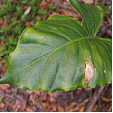 Alocasia species
Alocasia species 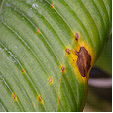
Alternaria Leaf Spot (Alternaria nelumbii) forms a small reddish brown spots that are boarded in light green, and as they develop in size the leaf curls and dies from the margin inwards. Normally occurs on Nelumbo species (water lilies).
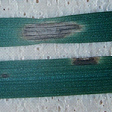 Helminthosporium Disease
Helminthosporium Disease
Helminthosporium Disease (Bipolris species), (Drechslera species) and (Exserophilum species) are responsible for several leaf spots that occur on all Turf Grass species. Generally they form black or white spots that may be faded and produce masses of spores in the thatch during late summer, under humid conditions. The life cycle is short and when conditions are favourable spores are splashed onto the foliage from the thatch, causing wide spread infection. Cynodon dactylon (common couch) is most susceptible and found in bowling or golf greens where it is a serious problem.
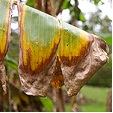 Banana Leaf Spot
Banana Leaf Spot 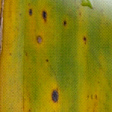
Banana Leaf Spot (Mycosphaerella musicola) is found on many species of banana causing pale yellow streaks on the young leaves to turn brown with dark spots. The leaf then becomes dried, brown and dead commencing from the margins, eventually the leaf dies. Control requires removal of infected foliage or the spraying of a fungicide and fungicides should not be used during the fruiting period.
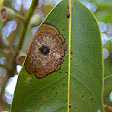
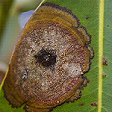 Lophostemon confertus (Brush Box)
Lophostemon confertus (Brush Box)
Leaf Spot on Brush Box (Elsinoe species). This is a casual fungus that attacks the epidermal layer of the leaf, forming circular spots that are up to 25mm across and are often restricted by the main vein. These spots are a dull yellowish brown but can also have purplish patterns. A leaf may have more than one spot develop on its surface and normally appears on scattered leaves throughout the tree. This doesn't affect the vigour of Lophostemon confertus.
Palm Leaf-scab (Graphiola phoeicis) appears as yellow spots and develop into scabs or warts that are outwards hard and dark but with a soft centre with powdery yellowish brown spores. The infected leaves eventually die.
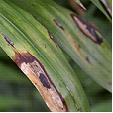 Palm Leaf Spot, Chamaedorea elegans
Palm Leaf Spot, Chamaedorea elegans
Palm Leaf Spot (Pestaloptiopsis species) appears as a small spot with a dark centre on the leaves and affects palms that are growing in shaded humid positions and normally control is not required, though infected fronds should be removed.
Source and Dispersal
Infection source is other contaminated plants and the spores are spread by wind or by splashing water. The fruiting bodies are black spots that appear on the damaged tissue releasing spores.
Favoured Conditions
This fungus prefers a warm humid environment and leafy plants with soft new growth, particularly if they are crowded.
Affected Plants
There are many ornamental and native plants that are hosts to a wide range of fungal leaf spots. Some specific ones are listed below. Plants such as Cornus or Paeonia species are infected by a large variety of leaf spots, while other plants attract a specific leaf spot.
Generally a healthy plant can tolerate fungal leaf spot attack, though it may make the plant look unsightly. In trees and shrubs it is difficult to control and generally not necessary, but in perennials and annuals control may be necessary in order to save the plant.
Acalypha and Arctotis species are infected by up to three leaf spots including (Cercospora acalyphae) and (Ramularia acalyphae) that rarely require control.
Acer species are infected by Purple Eye (Phyllosticta minima) which forms spots with brownish centres and purplish margins causing the death of the leaves.
Acer species are also infected by Tar Spot (Rhytisma acerinum) which forms round black spots that have yellow margins. Not normally seen on cultivated trees, but seen in forests.
Adiantum, Asplenium, Blechnum, Cyathea, Davallia, Nephrolepis, Platycerium, Polypodium and Pteris species are infected by the leaf spot (Pseudocercopora species) which forms circular brown spots on the fronds and heavy infection can defoliate a plant.
Aesculus species are occasionally infected with the leaf spot (Septoria hippocastani) which forms small brown spots.
Agave species are susceptible to the leaf spot (Coniothyrium concentricum), which appear as greyish spots up to 20mm (1in) across with concentric rings and black fruiting bodies. Affected leaves are destroyed as the infection spreads.
Albizia julibrissin is susceptible to the fungal leaf spot (gloeosporium aletridis), which does not normally require control.
Amelanchler, Chaenomeles, Crataegus and Rhaphiolepis species Mespilus germanica are infected by the leaf spot (Fabraea maculata) which may cause considerable damage during wet periods.
Aquilegia species can be infected by three types of Leaf Spot including (Ascochyta aquilegiae), (Cercospora aquilegiae) and (Septoria aquilegiae), normally appearing during humid conditions forming spots on the leaves.
Arbutus species are infected by two leaf spots (Septoria Unedonis) which produces small brown spots on the leaves and (Elsinoe mattirolianum).
Arctostaphylos manzanita is infected by the leave spot (Cryptostictis arbuti) which damages leaves but is not normally detrimental to the shrub.
Aspidistra species are infected by the leaf spot (Colletotrichum omnivorum) causing whitish spots on the leaves and petiole.
Aster species are infected by many leaf spots including (Alternaria species), (Cercosporella cana), ( Ovularia asteris) and (Septoria asteris).
Aucuba species are infected by several leaf spots, usually as a secondary infection after aphid attack. These include (Phyllosticta aucubae) and (Phyllostica aucubae).
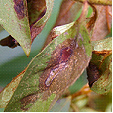
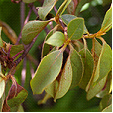 Azalea
Azalea
Azalea (Rhododendron species) are susceptible to Leaf Scorch (Septoria azalea). This fungal disease forms reddish- brown spots which expand and engulf the leaf, with fruiting bodies appearing in the centre. Infected leaves die, then fall and the branchlets wilt. This problem is more serious during wet periods and may require control using a fungicide.
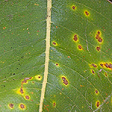 Banksia robur
Banksia robur
Banksia species are infected by several leaf spots causing chlorotic areas that have brown centres and is not normally a major problem for the plant.
Betula species may be infected by the Leaf Spots (Gloeosporium betularum) that forms brown spots with darker margins and (Cylindrosporium betulae) that also forms brown spots with faded indefinite margins.
Bougainvillea species are infected by the leaf spot (Cercosporidium bougainvilleae) which forms rounded spots with dark margins that yellowish ting. Infected leaves die and fall from the plant.
Calendula species are infected by the Leaf Spot (Cercospora calendulae) which rapidly infects the plant spotting the leaves and killing the plant.
Callicarpa species may be infected by the leaf spot (Atractilina callicarpae) forming irregular brownish spot or (Cercospora callicarpae) which can defoliate the plant in subtropical climates.
Campsis species may be infected by several fungal leaf spots including (Phyllosticta tecomae), (Septoria tecomae) and (Cercospora duplicata).
Carpinus species are infected by the leaf spots (Gloeosporium robergei), (Gnomoniella fimbriata) and (Septoria carpinea), all are minor infections not normally requiring control.
Carya species are infected by several leaf spots including (Gnomonia caryae) that infects leaves with irregular reddish spots on the upper surface with corresponding brown spore producing spots on the underside. It also has a secondary spore release that occurs on the dead leaves where it over winters. Other leaf spots include (monochaetia desmazierii) and (Marssonina juglandis).
Ceanothus species are susceptible to the leaf spot (Cercospora ceanothi) and (Phyllosticta ceanothi) both are of minor importance not requiring control.
Celtis species are infected by many leaf spots including (Cercosporella celtidis), (Cylindrosporium celtidis), (Phleospora celtidis) and (Septogloeum celtidis).
Chrysanthemums species are infected by the leaf spot (Septoria species) which forms yellow spots appear toward the edge of the leaves; these become enlarged brownish patches with yellow margins. Damaged areas may converge and in severe attacks and the leaves may fall prematurely or flower production is reduced.
Clematis species are infected by the fungal disease (Ascochyta clematidina) which may cause stem rot or leaf spots that are water soaked areas with reddish margins. The infection spreads from the leaves to the stem causing wilting and eventually girdling the stem killing the plant. There are many fungal leaf spots that infect this plant including (Cercospora rubigo) and (Septoria clematidis)
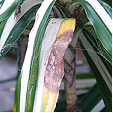 Dracaena deremensis
Dracaena deremensis
Cordyline and Dracaena species may be infected by the leaf spot (Phyllosticta maculicola) which forms small brownish spots that have yellowish margins and has black fruiting bodies that forms coils of spores. These plants are also susceptible to other leaf spots such as (Glomerella cincta) and (Phyllosticta dracaaaenae). Keep foliage dry to avoid infection.
Cynodon dactylon, Pennisetum clandestinum and many other Turf Grasses are susceptible to Helminthosporium Disease.
Daphne species are infected by the leaf spot (Gloeosporium mezerei) and (Marssonina daphnes) both of which form thickish brown spots that are seen on both sides of the leaves. Infected leaves turn yellowish before dieing.
Dendranthema species are infected by many leaf spots such as (Septoria chrysanthemi) which first forms yellowish spots up to 25mm (1in) across that become black. Infected leaves die prematurely and persist on the plant.
Dianthus species may be infected by the leaf spot (Septoria dianthi). It forms light brown rounded spots that have a purplish border. The scattered spots on the lower leaves can also be found on the stems and the spores are dispersed by water from the tiny black fruiting bodies.
Dieffenbachia species are infected by several leaf spot fungi including (Cephalosporium species) and (Myrothecium species).
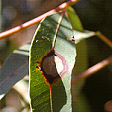 Eucalyptus species
Eucalyptus species
Eucalyptus species are infected by many fungal leaf spots such as (Mycosphaeralla species), (Hendersonia species) and (Monocheatia monochaeta). Generally leaf spots appear on the juvenile or new leaves causing brownish spots that enlarge and may have a purplish halo around the margin. Mature adult leaves are not normally infected and the trees rarely require control measures.
Fern species are infected by the leaf spot, (Alternaria polypodii). This fungus appears as brown circular or oblong spots that congregate along the margins of the pinnae causing the fronds to turn brown and die. It is spread by wind currents from plant to plant and control methods include removing infected fronds and maintaining a drier atmosphere.
Ficus species are infected by various fungal leaf spot including (Pseudocercospora species). Generally the fungal attack forms circular or irregular dark coloured spots on the leaves eventually causing them to fall prematurely.
Ficus elastica is susceptible to many fungal leaf spots including (Alternaria species), (Leptostromella elastica) and (Phyllosticta roberti).
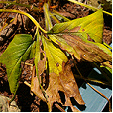
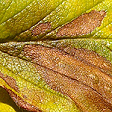 Strawberry
Strawberry
Fragaria x ananassa (Strawberry) is infected by the fungal leaf spot (Mycospharella fragariae). The mature leaf is initially infected with well defined brown spots that that turn light grey with red-purplish margins. As the spots merge they form large brown blotches and the leaf turns yellow then dies. This fungal attack normally occurs on plants in poor health and can be a serious problem early in the season seriously damaging stock.
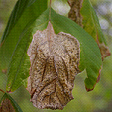 Fraxinus species
Fraxinus species
Fraxinus species are infected by the leaf spot (Gloeosporium aridum) giving the leaf a scorched appearance as large blotches appear from the margin or apex and turn brown with a papery texture. It is more prevalent during rainy periods and infected leaves fall prematurely. Collect and depose of fallen leaves otherwise control is not normally required.
Fuchsia species may be infected by the leaf spot (Septoria species) or ( Cercospora species), both form spots with dead centres and dark margins.
Gladiolus species are infected by Hard Rot or Leaf Spot (Septoria gladioli). On the corms reddish brown circular water soaked spots become large and sunken. These areas dry out and form obvious margins. The leaves may also have these symptoms but is not commonly seen.
Hemerocallis species are infected by several leaf spots including (Cercospora hemerocallis) and (Heterosporium iridis). These may be in the form of black spots or brownish spots that converge killing the leaf. Infected leaves should be removed and burnt.
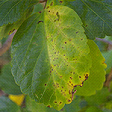 Hibiscus species
Hibiscus species
Hibiscus rosa-sinensis, Hibiscus syriacus and Hibiscus tiliaceus are susceptible to several fungal leaf spots including (Ascochyta abelmoschi), (Cerospora kellermanii) and (Phyllosticta hibiscina). All cause spotting or blotching of the leaf surface; remove and destroy infected parts.
Hydrangea species are infected by four fungal species including (Ascochyta hydrangeae), (Phyllosticta hydrangeae) and (Septoria hydrangeae).
Iris species are infected by several fungal leaf spots including (Alternaria iridicola) and (Macosphaerella species).
Iris species are also infected by the leaf spot (Didymellina macrospore) that forms greyish spots with brown water soaked borders and coalesce on the upper part of the leaf. This casual organism commonly occurs after flowering killing the leaves but will not infect the bulbs. The bulbs become weak over several seasons due to the decreased foliage.
There is also a Bacterial Leaf Spot (Bacterium tardicrescens) that is commonly mistaken as a fungal problem causing translucent spots that coalesce and involve the entire leaf. Normally found on Iris species.
Laburnum anagyroides is infected by the Leaf Spot (Phyllosticta cytisii). The leaf forms light grey spots with no definite margin and mature to brown. The black fruiting bodies appear as dots in the centre of the spot.
Leucanthemum species are infected by the leaf spot (Cerocspora chrysanthemi) and (Septoria leucanthemi).
Magnolia species are susceptible to many species including (Alternaria tenuis), (Mycosphaerella milleri) and (Phyllosticta species). Leaves generally turn brown from the apex or margins turning brown or spots appear on the leaf surface and leaves become yellow before withering and dieing. Normally the make the tree look poorly but have little effect on its growth. Control is not normally required.
Nerium oleander is susceptible to several fungal leaf spots including (Cercospora nerella), (Cercospora repens), (Gloesporium species) and (Phyllosticta nerii). Infected leaves should be removed but generally control is not required.
Nyssa sylvatica is infected by the leaf spot (Mycosphaerella nyssaecola) forming irregular purplish blotches.
Orchids such as Cattleya, Cymbidium, Cypripedium, Dendrobium, Epidendrum, Paphiopedilum, Phalaenopsis and Zygopetalum species are infected by several leaf spots including (Cerospora, Colletotrichum and Phyllosticta species). Normally forming dark or dead, circular or irregular areas on the leaves.
Palms such as Syagrus, Howea, Phoenix, Roystonea and Washingtonia species are infected by Leaf-scab (Graphiola phoeicis).
Palms such as Archontophoenix, Caryota, Chamaedorea, Cocos, Dypsis, Howea, Liculia, Linospadix, Livistona, Phoenix, Ptychosperma, Rhapis, Roystonea, Syagrus, Washingtonia and Wodyetia species are susceptible to several fungal leaf spots including;
(Bipolaris spp.), (Cylindrocladium spp.), (Colletotrichum spp.) and (Pestalotiopsis spp.).
Generally the circular leaf spots are brown and may have a yellow halo such as Palm Ring Spot (Bipolaris incurvata). They vary in size from small to large depending on the species. When a plant is healthy it recovers from attack, but heavy infections can defoliate, causing the collapse of the plant.
Palms are also infected by the Brachybasidium Leaf Spot (Brachybasidium pinangae). This fungus forms angular leaf lesions that produce fruiting bodies on the underside and is commonly found on Archontophoenix species.
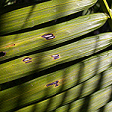
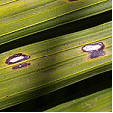 Archontophoenix cunninghamiana
Archontophoenix cunninghamiana
Passiflora species are infected with many types of leaf spot such as (Alternaria passiflorae).
Phoenix species are susceptible to False Smut (Graphiola phoenicis). This fungus forms yellow leaf spots that become hard with a raised with a blackish scab, which produces masses of powdery spores that are thread-like.
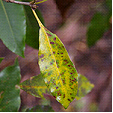
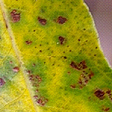 Pittosporum species
Pittosporum species
Pittosporum species are susceptible to the leaf spots (Alternaria tenuissima), (Phyllostica species) and (Cercospora pittospori). Circular or angular dark spots appear on the leaves and are surrounded by necrotic areas that are yellowish. Generally removal of infected leaves is adequate control.
Poa species and other cool season grasses are infected by Winter Fusarium Leaf Disease (Fusarium species), which causes small pale spots that are water soaked to appear on the leaves that turn red-brown. Infected leaves become bleached then wither and die, but the infection will not affect the crown or roots of the plant. It can be identified by pink, cotton-like mycelium and the plant prefers cold wet weather.
Populus species are infected by several fungal leaf spots including (Ciborinia bifrons, Ciborinia confundens), and (Mycosphaerella populicola).
Prunus species are infected by several leaf spots including (Cercospora circumscissa and Septoria ravenelii).
Pseudotsuga menziesii Douglas Fir is infected by the Leaf Cast (Rhabdocline pseudotsugae) Symptoms include the needles becoming yellowish at the apex and extending down the needle and spreading to others during moist spring weather turning them brown. Brownish scorched areas are noticeable on the tree from a distance. Control; is not normally required for mature trees but nursery stock may require spraying with a copper based fungicide.
Psidium guajava (Guava) is infected by (Glomerella cingulate). This fungus courses spots to appear on leaves and mummifies and blackens immature fruit or rots mature fruit. This fungus can devastate a guava crop.
Quercus species are infected by several types of leaf spot including (Cylindrosporium microspilum) and (Marssonina martini). These attacks tend top take place later in the season and normally not detrimental to the tree.
Rhododendron species are infected by a large variety of fungal leaf spots including (Cercospora rhododendri) and (lophodermium melaleucum)
Salix species are infected by several fungal leaf spots including (Ascochyta salicis) and (Septogloeum salicinum).
Senecio species are infected by the fungal leaf spot (Alternaria cinerariae) and (Cercospora species), forming dark rounded or angular spots.
Spiraea species are attacked by the fungal leaf spot (Cylindrosporium filipendulae).
Stenotaphrum secundatum (Buffalo) turf grass is susceptible to Grey Leaf Spot (Pyricularia grisea) in domestic and commercial situations devastating lawns. This fungal disease infects the stems and leaves with small brown lesions that enlarge rapidly forming grey-brown spots that have darker borders or surrounded by yellow chlorotic areas. This infection is commonly found on newly laid turf but will also infect established lawns. It is most prevalent during warm humid periods in soil with a high nitrogen level.
Syringa species are attacked by up to six species of leaf spot including (Cercospora lilacis) and (Phyllostica species).
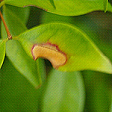 Syzygium species
Syzygium species
Syzygium species are infected by fungal leaf spots but normally control is not required.
Tagetes species are infected by the leaf spot (Septoria tageticola), which starts at the base and moves progressively up through the plant, covering the leaves in grey to black spots.
Trillium species are host to several leaf spots, including (Colletotrichum peckii) (Gloeosporium Trillii) (Heterosporium trillii).
Ulmus species are infected by many fungal leaf spots including (Gnomonia ulmea) and (Cercospora sphaeriaeformis).
Veronica species are infected by the leaf spot (Septoria veronicae). The symptoms include small violet to brown spots appear on the upper surface of the leaf and correspondingly yellowish brown on the underside. The spots converge forming a scorched shot-hole appearance and eventually death of the leaf.
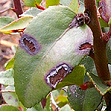 Vaccinium ovatum
Vaccinium ovatum
Vaccinium ovatum is infected by the leaf spot (Rhytisma vaccinii) and (Dothichiza caroliniana).
Vicia species are infected by the leaf spot (Erostrotheca multiformis), which forms greyish spots that enlarge and may defoliate the plant.
Wisteria species are infected by three fungal leaf spots (Phyllostica wisteriae), (Septoria wisteriae) and (Phomatospora wisteriae).
Non-chemical Control
Remove and destroy infected plant material and avoid overhead watering. When planting select infection resistant varieties. Practice crop rotation and add pot ash to the soil to decrease the plants venerability to the disease. Many species of fungus overwinter in fallen leaves, remove and destroy any litter under the plant.
Winter Fusarium Leaf Disease in Turf Grasses can be minimised by aerating the soil, reducing thatch and avoid excessive nitrogen in the soil.
Chemical Control
Protective fungicides such as zineb or copper oxychloride should be sprayed at the first sign of infection and cuttings should be sprayed as they start to grow.
Note
Always read the label for registration details and direction of use prior to application of any chemicals.
DISEASE
NAME
Grey Mould
Botrytis cinerea, B. elliptica
Description
Grey Mold, Shoot Blight, Petal Blight is a fungus problem that generally forms water-soaked spots that rot and produces greyish sclerotia (fungal resting bodies) on the surface. They can be found throughout the year on dead tissue and on live material during under ideal climatic conditions. Damaged areas such as a tear in a leaf or an opening made by an insect are more likely to be infected.
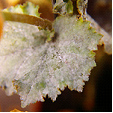 Grey Mold on Begonia species
Grey Mold on Begonia species
Image by B. Sonsie
Symptoms
The fungus attacks stems, leaves, flowers and fruit. In roses the fungus is primarily attacks the flowers producing pink rings on the petals and buds that become brown and rotten. This may extend down the peduncle to the stems causing dieback.
In other plants oval yellowish to brown spots appear, then the centre turns greyish and dries out and in humid weather the spots spread, joining up and infecting the entire leaf. This infection may also occur on the stems, and flowers may form abnormally or brown off and die.
When lettuce is infected it starts at the base causing a soft brown rot that may extend up the stem killing the plant, and pears flowers become infected then spreading to the fruit. This develops a sunken brown area that is soft and eventually is covered in grey powdery spores.
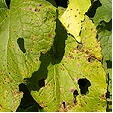
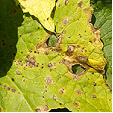 Botrytis Blight on Senecio cruentus
Botrytis Blight on Senecio cruentus
Botrytis Blight (Botrytis tulipae) infects leaves, flowers and stems with flecks of brown spots that merge to form light grey rotted areas that have brownish margin that may destroy stems. Affected areas are covered in a grey mould during humid conditions. The spores overwinter in dark brown sclerotia, which are found on the outer scales of the bulb or at the base of the stem in Tulipa species.
Grey Bulb Rot (Rhizoctonia tuliparum), which infects the bulbs of Tulipa species, attacking the base of the leaves and rotting the bulb. When bulbs emerge during spring in infected soil's they soon die off. The greyish mold tends to be dry.
Source and Dispersal
The sclerotia (fungal resting bodies) are found on dead plant material or in the soil and remain viable for many years. The spores are dispersed by wind or splashing water.
Favoured Conditions
It prefers cool moist climate with morning dew.
Affected Plants
Grey Mold attacks a wide range of plants including roses, fruit trees, pelargonium, ferns, grapes and cyclamens. Heliotropium , Amaryllis, Lilium and Hippeastrum species are also infected.
Agave species are infected by two fungal Leaf Blights (Botrytis cinerea) and (Stagonospora gigantea) that severely damage the leaves particular during wet periods or from excessive watering.
Cactus species are infected by soft rot or Grey Mould (Botrytis cinerea). Stems and pads turn are greyish with the upper surface, rotting then collapsing. The dieing tissue becomes slimy and is covered with grey mould that develops black sclerotia, which propagates the disease. It is more prevalent under warm humid conditions and control methods include removing infected parts and destroying them. In glasshouse situations ventilation should be improved and watering should be restricted to create a drier atmosphere.
Cereus species and other cacti are infected by Grey Mold causing the segments to become discoloured and as the rot progresses it tissue becomes slimy and collapses. Black sclerotia forms on the affected areas that are covered in grey mold during humid conditions.
Cuphea species are infected by this blight.
Orchids such as Cattleya, Cymbidium, Cypripedium, Dendrobium, Epidendrum, Oncidium, Paphiopedilum, Phalaenopsis and Zygopetalum species are infected by Grey Mold or Petal Spot (Botrytis cinerea). Petal and flower stalks form small brown spots.
Paeonia species are infected by Botrytis Blight (Botrytis paeoniae) causing the leaves and flowers to form a grey mold then suddenly collapse and die.
Pseudotsuga menziesii Douglas Fir is infected by Leaf and Twig Blight (Botrytis cinerea). This is a serious problem in wet conditions and is difficult to control.
Ribes species are attacked by Cain Blight (Botryosphaeria dothidea). The infection causes the cains to become blighted and wilt. To control remove damaged wood and destroy.
Non-chemical Control
Remove and destroy infected plants or fallen leaves. When planting, space as to allow good air movement to reduce humidity. Bulbs that are infected should be discarded and take care that bulb scales are removed from the soil to prevent further infection. Cactus and succulents that are infected should have the damaged areas cut out, or discard the entire plant. Under glasshouse conditions improve the ventilation and reduce watering to create a drier atmosphere.
Chemical Control
Under humid conditions spray regularly using a suitable fungicide such as thiram, mancozeb, dichloran and chlorothalonil.
Note
Always read the label for registration details and direction of use prior to application of any chemicals.
DISEASE
NAME
Leaf Blight (General)
Various Leaf Blight Species
Description
A fungal problem that attacks the leaves and may spread to other parts.
Symptoms
Generally light to dark brown patches or spots appear on the leaves. These join together causing the leaf to become dried and withered. Infected leaves fall prematurely and dieback occurs in the stems. The overall effect is a sparsely foliaged tree.
On Carrots the fungus (Alternaria dauci) forms small spots that turn the affected area yellow. This can spread over the entire plant resulting in the death of the plant.
Leptosphaerulina Leaf Blight (Leptosphaerulina species) infects Turf Grass. Generally the leaves turn light brown and wilt and from a distance, appear as irregular yellow brown patches. The leaves initially die back from the tip forming water soaked lesions that extend to the sheath and give them a bleached appearance. The fruiting bodies develop on the dead material and the spores are distributed by wind. This fungus appears on many grasses but is only a significant problem for Agrostis palustris (Bent) particularly during hot humid conditions.
Palm Leaf Blight (Pestalotia palmarum) forms grey brown spots on the leaf blades and penetrates into the leaflet axil turning the leaflets brown and killing the frond. Spores appear in black masses on the upper leaf surface. Another Palm Blight (Pestalotia palmicola) infects leaflet tips and progresses down throughout the frond turning it brown.


Strawberry leaf blight (Phomopsis obscurans) infects the leaves primarily with a triangular shaped patch that is reddish turning to brown. It is also found on the petioles and stolons and the tiny black fruiting bodies occur on damaged areas.
The fungal Leaf Blight (Didymascella thujina) forms brownish raised spots on small leaves tuning them brown during late spring and giving them a scorched, dead appearance, eventually falling from the plant during autumn. Commonly found on large Thuja species, but may also attack smaller varieties.
Umbrella leaf blight (Alternaria panax) forms dark brown to black patches that enlarge and distort immature leaves.
Source and Dispersal
The spores originate from other infected trees and are dispersed by wind or infected nursery stock. Once a plant is infected it can moves rapidly throughout. Certain species of tree can tolerate infection.
Favoured Conditions
It prefers humid still conditions with warm temperatures and is particularly a problem in tropical areas.
Affected Plants
A wide range of plants including vegetables, shrubs and trees may be affected.
Hibiscus species leaves are infected by Pellicularia koleroga a soil born fungus.
Leaf Blight (Pestalotia palmarum) infects several palms including Syagrus romanzoffianum and leaf blight (Pestalotia palmicola) attacks Phoenix, Syagrus and Washingtonia species.
Primula species are infected by the Leaf Blight (Phyllosticta prinulicola).
Syringa species are infected with the leaf blights (Cladosporium herbarum) and (Heterosporium syringae) which form large brown spots on the leaves that become dry and fall out.
Tilia species particularly young trees are in infected by the casual fungus (Cercospora microsora), which forms brown spots with darker borders, resulting in the death of the leaf.
Tsuga species are infected by the leaf blight (didymascella tsugae), which turns the leaves brown causing them to fall prematurely.
Non-chemical Control
On small trees remove and destroy the infected parts or in a nursery remove and destroy infected stock. Perennials and annuals should be removed and destroyed. Remove any fallen leaves from around the base of the plant as they contain fruiting bodies.
Chemical Control
Plants may be sprayed at five day intervals with copper oxychloride if possible. Turf infected with Leptosphaerulina Leaf Blight may be sprayed with a broad spectrum fungicide.
Note
Always read the label for registration details and direction of use prior to application of any chemicals.
Average Lowest Temperature : -1º C 30º F
USDA : 9, 10, 11, 12
This USDA (United States Department of Agriculture) hardiness zone chart can be used to indicate a plant’s ability to withstand average minimum temperatures. However, other factors such as soil type, pH, and moisture, drainage, humidity and exposure to sun and wind will also have a direct effect on your plant’s survival. Use this chart only as a guide, always keep the other factors in mind when deciding where, when and what to plant.
A plant's individual USDA zone can be found in the Plant Overview.
Region of origin
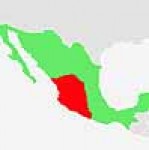
Mexico (central and western)
Climate Description
Warm to Sub-tropical
This overlaping zone has ample rain with high summer temeperatures and high humidity. Winters are mild. Pockets of sub-tropical climates exist within coastal warm temperate zones.
Frosts and droughts rarely occur along the coast.
Plant growth
Tropical and warm temperate native and exotic plants grow well.
| Dictionary | Growth Habit |
| Leaf Type | Botanic Flower Description |
| Leaf Shape | Flower Inflorescence |
| Leaf Arrangement | Fruit Type |
| Leaf Margin | Bark Type |
| Leaf Apex And Bases | Flower Description |